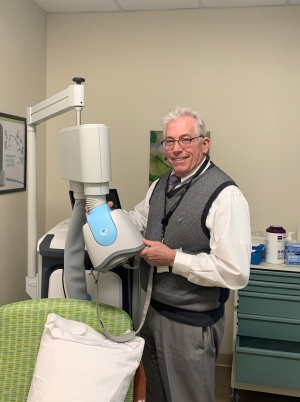
Kenneth Miller, then-chief of Transcranial Magnetic Stimulation Clinic at the Hampton, VA, VAMC, displayed the facility’s TMS machine in 2020.
BOSTON — Scientists studying post-traumatic stress disorder (PTSD) have been puzzled by several mysteries surrounding the condition, such as why military personnel with severe brain injuries are less likely to develop PTSD compared to those without any brain injury or why a neurostimulation therapy that has proven helpful for other mental health disorders actually worsened PTSD in some studies.
In a new study published in Nature Neuroscience, researchers offered answers to some of these questions and, with them, new hope to veterans struggling with difficult-to-treat PTSD.1
“The way it started is we were trying to find a new treatment target for PTSD using transcranial magnetic stimulation, or TMS,” said corresponding author Shan Siddiqi, MD, an assistant professor of psychiatry at Harvard Medical School and a neuropsychiatrist in the Center for Brain Therapeutics at Brigham and Women’s Hospital.
TMS is a noninvasive procedure that uses high-intensity magnetic fields to stimulate specific regions in the brain in an effort to change the activity of brain circuits, or groups of interconnected brain cells that control functions like movement, mood and behavior. It is Food and Drug Administration (FDA)-cleared and effective for treatment of depression and obsessive-compulsive disorder (OCD). It also has been used with some success for pain, as well as other mental health conditions.
For PTSD, however, the treatment not only didn’t work well in some trials, but, in some cases, might have worsened the condition. That left the researchers scratching their heads, he said. He reasoned that, in those studies, TMS was hitting the wrong part of the brain, or target.
Indeed, one of the biggest challenges of developing a brain stimulation treatment for PTSD has been identifying the therapeutic target, or brain circuit, which when inhibited or stimulated produces the desired result. In previous, unsuccessful, trials of TMS for PTSD, several studies had targeted the same circuit their team had devised for depression but, rather than continue a trial-and-error approach of testing different targets, they turned to brain lesions to map out the circuit for PTSD.
The team analyzed 193 patients with penetrating traumatic brain injuries from the Vietnam Head Injury Study, which was led by co-author Jordan Grafman, PhD, at Northwestern. They investigated whether these veterans developed PTSD two decades after the Vietnam War.2
Grafman mapped out the exact location of damage in each patient and what the neurologic effects of the damage were.
The researchers hypothesized that a specific brain circuit, when damaged by shrapnel, might protect against PTSD. They used the human connectome—a comprehensive neural wiring diagram, created through a large-scale, coordinated collaboration among scientists to map the brain in intricate detail—to map the locations of brain injuries and the areas each lesion affected. They then compared this data to 180 veterans without brain injuries, some with PTSD and some without.
Viable Treatment Target
The results showed that connectivity within this brain circuit was linked to whether the veterans had PTSD. Lastly, the team explored whether this circuit could be a viable treatment target by reviewing previous trials of TMS for PTSD.
“Prior studies incidentally stimulated many different circuits but didn’t know where or how or why they were doing it,” Siddiqi explained. “When some studies failed and others succeeded, nobody had a clear explanation of why, since they all used different targets and different fear/relaxation conditions. Our circuit seemed to unite all of the results into a common model—it successfully explained why some studies succeeded and others failed, based on the intersection of their target with our circuit.”
In the paper, the authors discussed the case of a patient with lifelong PTSD who sought treatment and opted for TMS on the newly identified target at his doctors’ recommendation. “We told him it has never been tried before, but if you want, you can be the first,” Siddiqi stated. “After an extensive informed-consent process, we gave him this new treatment target and it worked. His PTSD went into full remission.”
The biggest challenge facing the treatment target now is getting approval for insurance coverage, Siddiqi told U.S. Medicine. “We are encouraging various collaborators around the world to do clinical trials. When you have enough clinical trials, insurance eventually has to cover it.”
In the meantime, it is still possible for some veterans with PTSD to have TMS optimized with the new treatment target. Although insurance doesn’t cover TMS just for PTSD, it does cover TMS for depression.
“If you have a patient with both depression with and PTSD—and of course we have many of those patients at the VA—then the treatment can be further optimized for these specific patients. This study tells us how to optimize this treatment for those patients to improve outcomes.”
Siddiqi said the most important message he’d like to relay to clinicians is that “we have new, better treatments for mental illness. These treatments are available at many VAs across the country, so if the standard stuff isn’t working, make sure your patient knows there is hope with these newer treatments that are actually more effective.”
- Siddiqi SH, Philip NS, Palm ST, Carreon DM, et al. A potential target for noninvasive neuromodulation of PTSD symptoms derived from focal brain lesions in veterans. Nat Neurosci. 2024 Sep 24. doi: 10.1038/s41593-024-01772-7. Epub ahead of print. PMID: 39317797.
- Raymont V, Salazar AM, Krueger F, Grafman J. “Studying injured minds” —the Vietnam head injury study and 40 years of brain injury research. Front Neurol. 2011 Mar 28;2:15. doi: 10.3389/fneur.2011.00015. PMID: 21625624; PMCID: PMC3093742.

